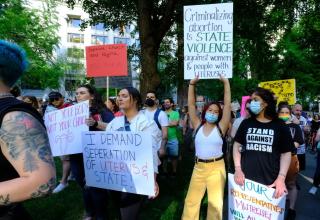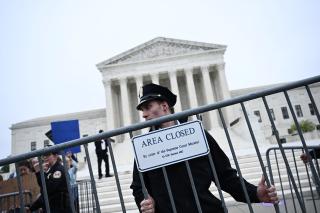Advertisement
Defenders of the U.S. Supreme Court’s current quest to turn back the clock on civil rights like to emphasize that the court is obliged to fulfill the words above its doors and realize “the promise of equal justice under law” rather than follow public opinion. Yet the court’s revocation of established rights in Dobbs v. Jackson diverges wildly from both. Can justice be served by citizens’ rights being revocable by state legislatures based on which party holds a majority at a given moment?
In its June Dobbs ruling, the SCOTUS majority discarded a half-century of precedent because the U.S. Constitution’s authors failed to affirm reproductive choice, and such freedom is not “deeply rooted in this Nation’s history and tradition.”
Let’s take a minute to unpack the rationale for rejecting rights not “rooted in tradition.” Our Constitutional conveners were wealthy white men who shut out women, people of color, and the working class from participating.
“We the People” excluded roughly 85 percent of Americans at the time the U.S. Constitution was written.
No women served as legislators or engaged in ratifying the Constitution in 1789. Few women of that era ever cast a vote, and “We the People”—based on data from The Right to Vote: The contested history of democracy in the United States by Alexander Keyssar—excluded roughly 85 percent of Americans at the time.
Despite the expansion of rights over the last two centuries to populations previously excluded, minority rule—that is, the government of those with entrenched power—remains in force today. Many people don’t recognize how our Constitution perpetuates eighteenth-century norms of racism, sexism, and other forms of bigotry that most Americans condemn. White supremacists’ work to restrict discussion of structural racism in schools is rooted in preventing such recognition and sustaining the status quo.
We’ve lived for decades with illusions that hard-fought victories permanently secured many civil rights and liberties. But unless freedoms are explicitly included in the Constitution, the whims of temporary legislative and court majorities may erase them —no matter how often we refer to them as “rights.” These include rights to same-sex marriage, non-heterosexual intimacy, and even contraception, which Justice Clarence Thomas suggested overruling in his concurring opinion.
Minority Rule on the Rise
Choosing presidents via the Electoral College is one element of minority rule, giving residents of overwhelmingly white, rural states up to three or more times the voting power of Californians, for example. Candidates who lost the popular vote became president three times during the 1800s, but in every twentieth-century election, the same candidate won the popular and electoral votes, forestalling reform efforts.
Then in 2000, a 5-4 U.S. Supreme Court ruling halted a full counting of votes in Florida, ultimately giving the state’s decisive electoral votes to the popular vote loser George W. Bush. The verdict sent Bush to the White House, where he went on to select two more Supreme Court justices.
Men who entered office while losing the popular vote chose five of nine current Supreme Court justices.
Incredibly, men who entered office while losing the popular vote chose five of nine current Supreme Court justices. Those five justices have eroded ballot access and legalized gerrymandered electoral districts that continuously disenfranchise many voters and further stifle the voices of the majority.
Also preventing democracy is the Constitution’s slavery-rooted structure of granting two Senate seats to each state. It is a rule that favors whiter, more rural states so much that voters in racially diverse California wield just 1/57 of voting power in the Senate compared to Wyoming residents. The fifty current Democratic and Independent senators received 41 million more votes than the fifty Republicans.

Protesters rally in Portland, Oregon, June 24, 2022, after the U.S. Supreme Court overturned
And it’s getting worse. By 2040, just under 70 percent of Americans will live in sixteen states but will be represented by less than one-third of the Senate!
Filibusters have further entrenched minority rule, most notably by enabling Republicans to block dozens of President Obama’s federal judicial nominees. Then Donald Trump’s 2016 Electoral College win gave him the power to pack the courts with far-right judges despite losing the popular vote by over 3 million people. Various anti-democratic features of our system, including elements of the Constitution, now effectively create a feedback loop to accelerate democratic decline.
In fighting back against the Dobbs ruling, Unitarian Universalists have a unique opportunity to successfully present faith-based arguments in defense of reproductive justice, to counter the argument by many abortion opponents who claim religious beliefs as their inspiration.
Various anti-democratic features of our system, including elements of the Constitution, now effectively create a feedback loop to accelerate democratic decline.
The current escalation of minority rule undermines virtually all core UU principles, and the Supreme Court has transformed from a defender of civil rights to their greatest threat. So what can be done about a SCOTUS packed with regressive activists? Options (to be explored more thoroughly in a future column) may include:
- Rebalancing the SCOTUS by expanding to thirteen justices (Congress has previously changed the size of the Court seven times);
- Carving out limits to SCOTUS’ authority, as our Constitution clearly permits;
- Recognizing that the Constitution granted SCOTUS supremacy over other courts, not supremacy over Congress or the president (though SCOTUS has claimed that power);
- Pushing to drive unprotected civil rights into the Constitution via Amendment.
UUs and all justice advocates still possess a public majority to slow and then stop the current tide of civil rights defeats. But, it’s essential to recognize the need for structural change not just to preserve previous civil rights advances but also to address and dismantle minority rule. It’s a pivotal path to realizing a genuinely inclusive democracy for all races, sexes, genders, abilities, and beliefs.
Jeff Milchen is a UU World National Correspondent and the UUA’s Justice Communications Associate. He welcomes your comments or questions. Tweet @JMilchen
